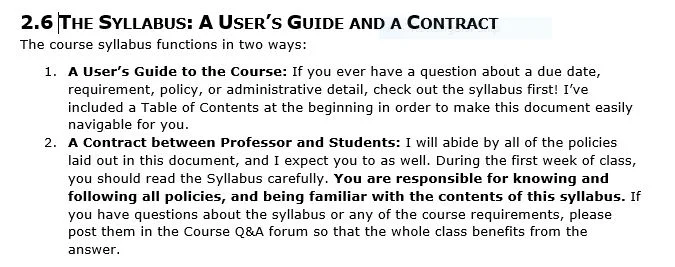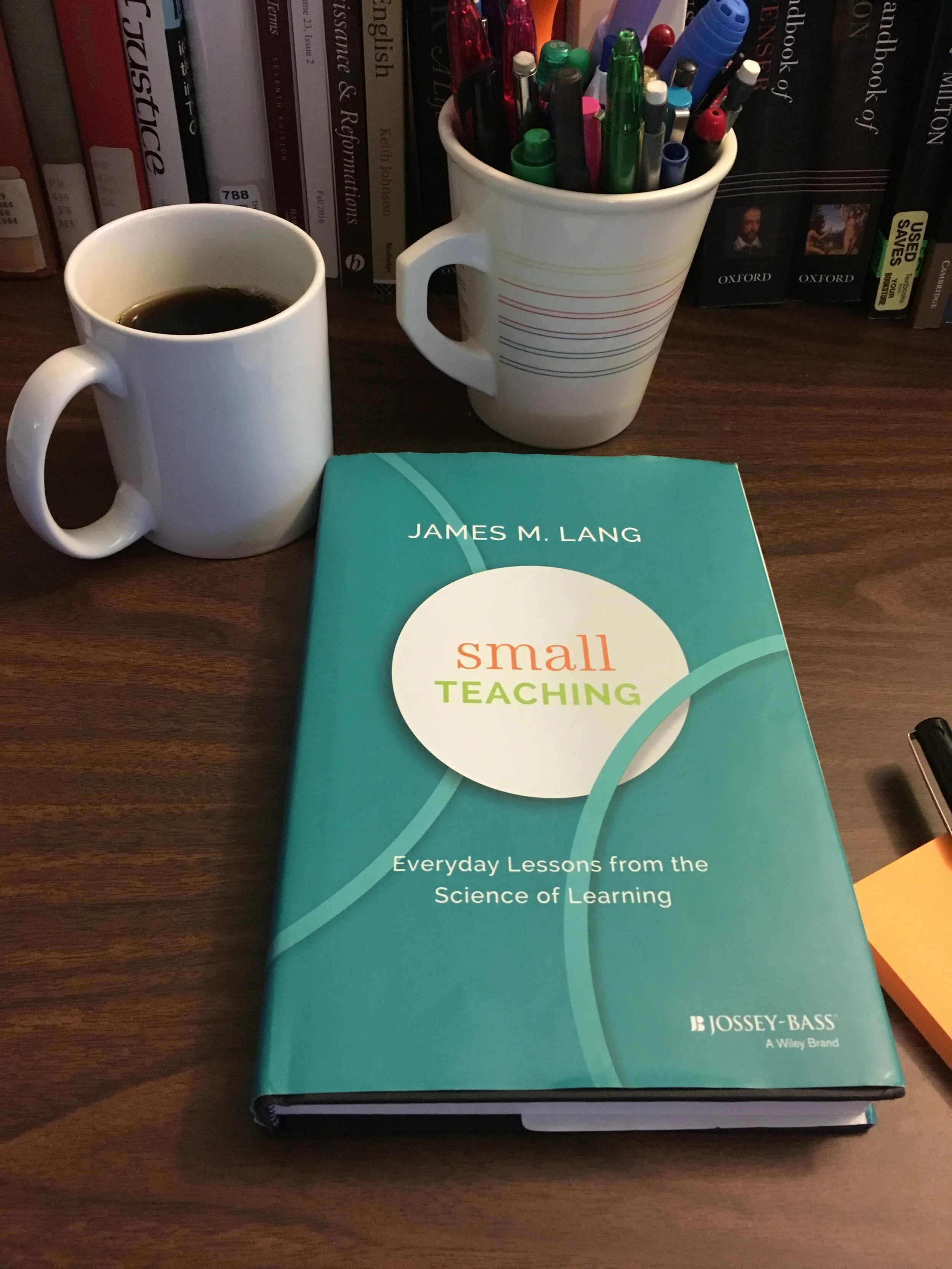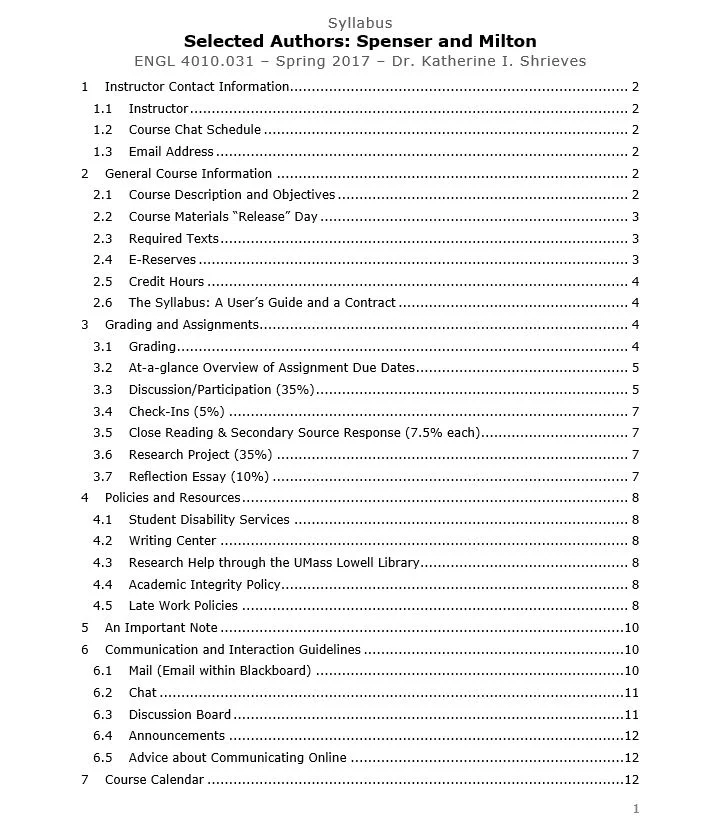In Defense of the Big Syllabus, Part 2: Student-Centered Design
How many people actually read software EULAs? I honestly don’t, and I don’t want my syllabus to sound like one, either.
That said, there’s no getting around the fact that a comprehensive syllabus is long, so what’s an instructor to do? In Part 1 of this essay series, I talked about the research and practice supporting detailed syllabi. Today, I'll talk about how to craft a document that's both comprehensive and student-centered.
Warmth and Relevance
When the syllabus is written in a friendly tone, students are inspired to think that their instructor will be more warm, approachable, and (perhaps most importantly) invested in student success. The importance of tone has been borne out in qualitative research: Harnish and Bridges discovered that students responded better to syllabi with personal, inviting phrasing such as “I hope you actively participate” versus straightforward commands such as “Come prepared to actively participate” (323).
Current theories of andragogy suggest that adult learners respond better when they understand the “why” behind their learning experiences, which leads them to feel as though they have more agency. Fornaciari and Lund Dean argue that these principles could emerge, among other things, in a syllabus that incorporates “more positive, learning-oriented policy statements” along with rationales for policy decisions, and that eschews “contractual and consequential language” in favor of “encouraging and student-owned experiences” (713).
In my syllabus, I try to balance the potentially conflicting imperatives of providing clear, detailed policy information and connecting with students through an approachable tone. Letting my own voice come through in the syllabus lays the groundwork for strong instructor presence. Among other things, I want students to think of me as a real person who has put a lot of thought into crafting policies and designing this course.
Examples in Practice
Here are some examples of how these student-centered values emerge in my syllabus:
Lots of first person. The final outcome in my list of learning objectives is: “Have fun! Although this class is designed to challenge you intellectually, I hope you’ll also enjoy reading and discussing these works.”
Explaining policy decisions. In the class I’m using as an example, students could easily find the primary texts for free online or in countless different editions. Therefore, in order to persuade them to buy the editions that I’ve chose, I include an explanation of my rationale:
Please purchase only these assigned editions. In the case of The Faerie Queene, I’ve chosen the Hamilton/Yamashita/Suzuki edition specifically because of its excellent footnotes that will be essential in helping you to understand Spenser’s language and context. In the case of the Norton Critical edition of Paradise Lost, the book also contains many contextual documents and critical essays that will be assigned reading in the class. With Renaissance English poetry, it’s really important to use a high-quality edition so that modern readers (like you and me) understand the language, which has vocabulary and spelling that's a little different from today’s English, and also cultural references and literary allusions, which footnotes help to flesh out.
Emphasizing the relevance of course content and methods. In an English class, essays can sometimes seem like arbitrary exercises. Here’s an example of how my syllabus provides context for a major assignment:
In the field of English Studies, two of the most common ways that scholars share their ideas with each other are through articles and conference papers. In the Research Project, you have the option either to write an article for the audience of a specific Renaissance-related journal, or write and deliver (via screencast) a conference-style paper.
Reaching out to students. I also include a separate section titled “An Important Note” that encourages students to contact me if they’re struggling or if a special circumstance will make their coursework more challenging:
If you find yourself struggling to keep up with participation or assignments, the most important thing you can do is keep in regular contact with me via Mail. If you simply drop off the face of the earth and start accruing failing grades, you will most likely fail this course. If I’m aware of your situation, we can try to work out a roadmap for rehabilitating your performance.
Furthermore, if you know that an upcoming situation will require special workarounds or affect your ability to complete classwork, contact me via Mail in advance. In previous semesters, successful students in my courses have planned ahead for special challenges including several weeks of international travel with limited internet access and even giving birth mid-semester. If you contact me well in advance, we can work together to make sure you have the resources and ability to keep up with your academics.*
So, do my students read all of this? Maybe, maybe not. Regardless, it’s there for them as the “user’s guide to the course,” and hopefully my language, policies, and explanatory content help set the tone for a semester that’s well-structured but also attentive to student needs, concerns, and motivations.
The comprehensive syllabus is here to stay. Let’s make it less about “visible absence of underwear” and more about providing a clear, detailed, user-friendly framework for the course.
Works Cited
Fornaciari, Charles J., and Kathy Lund Dean. "The 21st-century syllabus from pedagogy to andragogy." Journal of Management Education 38.5 (2014): 701-723.
Harnish, Richard J., and K. Robert Bridges. "Effect of syllabus tone: Students’ perceptions of instructor and course." Social Psychology of Education 14.3 (2011): 319-330.
* This is the version of the “Important Note” that I’ve used this semester, but I think that its tone could be improved further to make it sound less admonitory and more inviting.




